I have been asked in the past what we do in the winter months. People comment, saying “Surely as an arable farmer, you plant the crops in the autumn, go away on holiday and come back the following summer ready to harvest them?” Nice thought, but I’m afraid the reality is a little different.
Admittedly, on an arable farm, where we only grow crops and do not have any livestock to look after, the winter months are quiet and it can be an opportunity to relax on a holiday if you wish. However, I have always found it the time of year for research, planning and projects, of which we have done many over the years. Back around the millennium, I remember spending many winter months researching the viability of creating a cold pressed rapeseed oil business on our farm, as a diversification project on something I found very interesting and to hopefully bring a little extra income to the family business. Looking back, I think this was time very well spent.
Of course winter is an ideal time for us to service all the farm machinery in preparation for the coming spring and summer months when we will want it to work long and hard without too many breakdowns. We have done many building projects over the years, both for new machinery ideas and for buildings on the farm. Some examples have been building a new trailer, or creating a water bowser. In the past, when I was a young boy and even before I was born, my Father and Grandfather were at their happiest creating new weird and wonderful machines in the farm workshop. Two of the most extravagant examples included a six-wheel drive tractor, converted from a World War II army fire engine. I remember going across the fields with them on this machine, before it finally over heated and was retired in the nettles. Their most famous project was when they took two normal tractors, replaced the standard engines with more powerful versions, before removing the front axils off both tractors and joining them together to make an articulated four-wheel drive machine, driven by one person from the back tractor. This was certainly cutting-edge engineering in its day, that was later copied and refined by machinery manufacturers in future years.
We have restored our beautiful traditional barns and converted them from redundant old farm buildings into offices, including our farm office today. New modern grain stores have been designed and built to cope with storing and drying the grain at the speed the modern combine harvester brings the crops in. Over the years, we have built all of the factory and some of the machinery inside it for Farrington Oils. Some of these projects seem to start as winter job ideas, but tend to stretch through other months of the year and before long take on a whole life of their own. The most recent being the latest expansion of Farrington Oils to create a new toilet and changing facilities, as well as extra space to mix our salad dressings and store ingredients. We have even made a little development kitchen in which Eli is currently very busy with her trusted jam jar creating some possible exciting new dressing recipes. This whole project started in April last year, we had a few weeks break for harvest to take place, before finally finishing the project just before Christmas.
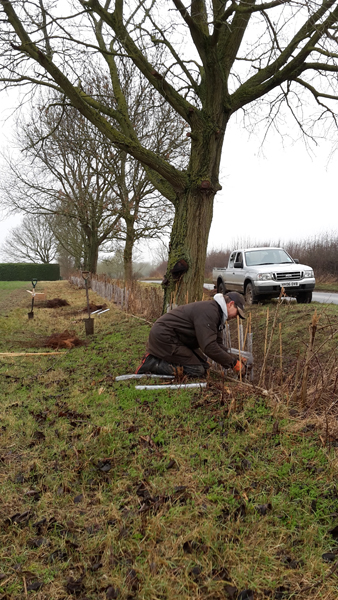
Marvin planting saplings in Jan 2018
The other main type of project we have done during winter over the years is planting trees and hedges. We have literally planted thousands of trees and several kilometres of hedges since 1987 when my Father planted the first couple of spinneys on the farm. They are now well established, adding beauty and wildlife habitats to the landscape. This year we have been at it again. Marvin spent the time before Christmas with the chainsaw, thinning out dead wood from a copse area and old hedge, in readiness to replant with new young saplings in the first weeks of January. He has now created a few hundred more metres of hedgerow – Father and I have helped him with the spade to get some of the 2,000 hedge and tree plants put into the soil. We will have to weed around the young saplings for the first two years, after that they will hopefully grow and thrive, adding more beauty and wildlife habitat for many years to come. Additionally, we have a pile of wood ready to cut up for the fire to keep us warm at home next year.
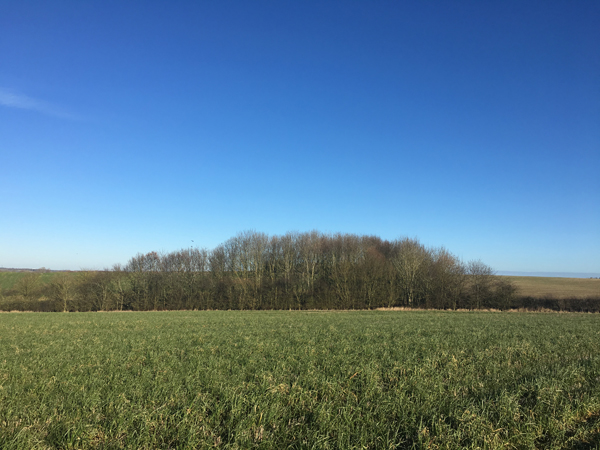
Spinney on Bottom Farm that was planted in 1987, photo taken Feb 2018.
Although winter on Bottom Farm may not be spent on a combine harvester or tractor, it certainly is far from quiet!
Some days, events in the news or experiences of friends near to us, remind us how lucky we are. I am fortunate to have the support of a loving and healthy family around me, great friends, a stable and exciting career, with some great people who help make Farrington’s Mellow Yellow the success it is. Of course, there are days when life is a bit of a struggle and, as Eli will testify, I can get a bit grumpy and stressed on occasion. However, compared to some people in the world, we have a pretty good lot.
I originally looked at starting Farrington Oils as a farm diversification. The aim was to try and create a more sustainable income so Eli and I could continue to live and work at Bottom Farm where our (at the time) young children could grow up. With the support of both of our parents, not to mention years of hard work, Farrington’s Mellow Yellow has become a great success, far exceeding what I originally envisaged. I am very proud of what we have achieved, not only providing Eli and I with a stable income, but also a livelihood for the small, dedicated team that work with us.
Our success is very much thanks to the many loyal customers who buy our products, some of whom have supported us since I first started making Britain’s original farm to bottle cold pressed rapeseed oil back in 2005. If I think about it too much, it is rather humbling and, perhaps because of this, I am keen that we should share some of our success with the community around us. Over the years, we have been proud to support several good causes.
I have always been keen to support young people, to try and inspire them in a small way, so they will have the confidence to ‘have a go’ and possibly stretch themselves to reach for goals they may not have thought they could achieve. This comes to life in some of the LEAF talks I hold at the farm or in schools. I love it when I talk about some of my experiences, the challenges and successes in starting and running your own business. I remember on one school visit, a girl asking if I was famous because there was a picture of my face was on our bottle of oil, and the excitement in the classroom that with a bit of hard work and passion they too might start something successful one day.
We have supported some charities close to our hearts over the years. The Faraway Children’s Charity is named after one of Enid Blyton’s children’s books: ‘The Faraway Tree’ which tells the story of a group of children who discover a magical tree where they are safe and happy. This great local charity came to our attention as Eli and I were shocked by the amount of absolute poverty all around us, in our supposed modern, developed economy. Volunteers help young vulnerable people in Northamptonshire to “survive, thrive and smile”. The charity was set up to support children, to give them simple things such as toiletries and clothing for example, or an Easter egg at Easter; to show them love and hopefully put a smile on their faces.
Another charity we have supported over the years is the Batten Disease Family Association (BDFA). This cause is incredibly close to our hearts; Batten Disease is a very rare and cruel neurological disease with very little known about it. There are only around 150 sufferers in the UK, including our close family friend Laura. Laura is a fantastic eighteen year old, crippled by the disease, but cared for with the love and help of her family. The BDFA helps support such families and to try and raise awareness for research into Battens.
We have also supported Children in Need by attending CarFest at Laverstoke Park each year and supplying the oil for their Foodie Workshops, which are always good fun. More generally, we always try to support local charity fundraisers and events when a request comes through for some Mellow Yellow products as a raffle prize, for example. Recently Farrington’s Mellow Yellow supported the Hargrave Music Festival. For four days in September, our sleepy little village played host to a series of classical concerts, opera performances and cabarets performed by world class acts. Not something you would expect in Hargrave, but a great weekend to put our community on the map. I even read on one of the performer’s credits that she had performed in Sydney, New York, London and Hargrave!
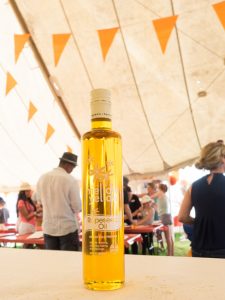
Finally, we are very proud to support our local Premiership rugby team, Northampton Saints. The club’s chef, Gavin Austin, has always been a great supporter of Mellow Yellow and when he moved to the Saints, he wanted to take his trusted oil with him. Our healthy range of oil, mayonnaise and salad dressings are now an integral part of these elite athletes’ diets.
Whatever you like to support, I greatly enjoy being in a position to be able to help others. In the past people have helped, inspired and supported me over the years. Besides, as well as giving you that warm fuzzy feeling when you support a cause you believe in, we have also had a bit of fun in doing so. Have a look at our Oilslide Challenge to see what I mean.

Situated on the top of a hill, looking out over the city of Peterborough, Hill Farm Pick Your Own has been selling Farrington’s Mellow Yellow for over 3 years now. As a pick your own farm, they are one of our more unique customers and definitely one to be proud of.
Founded in the 1970’s, Hill Farm PYO started out when John & Jill Ivens bought the farm and decided to change it from a traditional arable and livestock mixed farm to a pick your own farm, growing fresh produce and allowing the public to pick it themselves. They started off with sweetcorn and expanded into raspberries, then strawberries and all the other produce that can be found today. Hill Farm is now run by John & Jill’s son, Paddy, and his wife, Susannah. They grow an incredibly wide variety of fruits and vegetables, with the aim of extending the picking season so you can enjoy fresh, hand-picked fruit and veg for even longer. Strawberries have remained the best selling fruit each year, in fact most people know it as ‘the strawberry farm on the hill’, but pumpkins are now gaining popularity and are the second best seller. With the farm decorated with ghosts and pumpkins in all shapes and sizes, it’s not hard to see why people continue to flock to the farm in the cold of October.
We visited Hill Farm about a week into July, when there would normally be row upon row of strawberry-filled plants, however, due to the unexpectedly hot June we had this year, they were down to their last two varieties! This is one of the excitements of farming, so much is down to the weather. This year, everything has ripened at the same time rather than being spread out over the summer months. However, hidden in the rows there were still plenty of strawberries ripe for the picking!
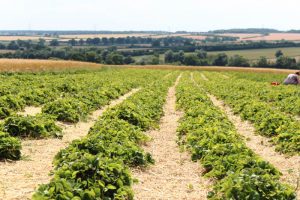
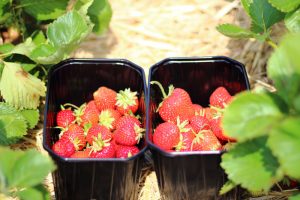
A few years ago, pick your own had a bit of a dip in popularity, but now it is definitely back in fashion and incredibly popular as a family day out. Susannah says that it takes people back to the old way of cooking; using seasonal vegetables when they’re available. Some people even visit the farm and pick buckets of fruit to be frozen and last them the entire summer.
Keeping the crops healthy is very important. Hill Farm PYO run on a 3 year crop rotation which helps maintain the soil and keep the fields producing the very best fruit and vegetables. As well as their crop rotation, Susannah and Paddy make sure that there is a daily inspection of the fields and that a different field is picked each day.
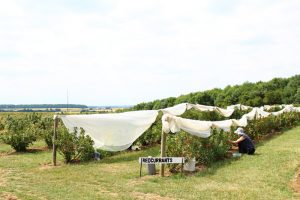
In addition to pick your own, Hill Farm also has a shop which sells a selection of pre-picked produce as well as local products, which is where we come in. Our full range of products is available on a beautiful stand behind the counter, and they tend to sell lots of our rapeseed oil later on in the year as it is perfect for when the squashes are in season. In fact, we have a brilliant recipe for squash season: http://farrington-oils.co.uk/recipe/chilli-chorizo-butternut-slice/ .

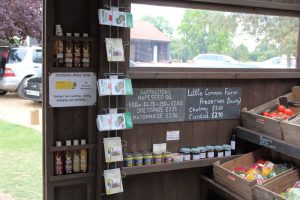
Hill Farm Pick Your Own is open from June to the end of October, so if you’re nearby it is definitely worth a visit this summer, just remember to call ahead to see what is available for picking each day. Website: www.hillfarmpyo.co.uk, phone number: 01733 233270.
Here at Farrington’s, we don’t use neonicotinoids on our rapeseed crop. This is for many reasons, mainly because of the concerns related to this pesticide and the effect on bees. You can read more about our bee friendly rapeseed and what else we do to keep the bees on our farm healthy and happy here.
Friends of the Earth, a campaign group looking for solutions to environmental problems, is concerned about the impact of neonicotinoids on bees and other pollinators and urged farmers to join them in pledging not to use neonicotinoids. We were asked us to join the Bee Friendly Shoppers Guide to Rapeseed Oil, of which we are 1 of only 7 rapeseed oil producers on this list. Of course we said yes! The guide aims to educate shoppers on which oils to buy, and how these oils are helping Britain’s bees. As part of the guide, we have pledged not to use the three neonicotinoid pesticides which are currently restricted across the EU, and will continue to avoid these pesticide even if the ban is lifted.
The Bee Friendly Shoppers Guide to Rapeseed Oil is supported by a number of leading chefs. These include Kevin Gratton, chef director for Mark Hix Restaurants, David Everitt-Matthias of Le Champignon Sauvage, Martin Burge, executive chef at Whatley Manor Hotel & Spa and Tom Hunt, eco chef owner of Poco Tapas Bar. Friends of the Earth, alongside the supporting farmers and chefs, are asking consumers to support the initiative by buying the bee-friendly rapeseed oils detailed in the guide.
Friends of the Earth’s Bee Campaigner, Nick Rau, said “We’re delighted Farrington’s Mellow Yellow is standing up for Britain’s bees by pledging not to use these three bee-harming pesticides on their rapeseed crops. They deserve our support. We hope more farmers and producers follow their lead and say no to these neonicotinoid pesticides. Nature-loving shoppers can back this pioneering initiative by checking out the Bee Friendly Shoppers Guide to Rapeseed Oil and choosing these products in supermarkets, local stores and online.”
To read more about the Bee Friendly Shoppers Guide to Rapeseed Oil, please visit: http://www.rapeseedoilguide.com/
Back in 2012, thanks to the growing success of Farrington’s Mellow Yellow we started using rapeseed from a second farm, working with our neighbours, in addition to the seed we grow on our own farm. See my blog; “Mellow Yellow Popularity Grows” April 10, 2012. Now, we have added a third farmer to the list.
The Bletsoe and Farrington families have been neighbouring farmers since at least my great grandfather’s day. Like most farming neighbours, we have developed strong friendships over those generations, built on trust and the odd bit of occasional light hearted banter.
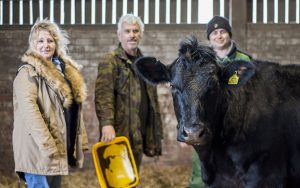
Emma Bletsoe has, for several years, used our rapemeal, produced as the by-product from pressing the oil out of the seed, to feed her cattle. Then a couple of years ago, Emma and I were chatting at a local gathering, when the conversation moved on to her rapeseed crop and my future needs for more LEAF Marque rapeseed. Emma thought that as well as buying the meal off us, perhaps she could also sell us her seed in the first place. Emma and her guys on the farm, Garry and Stuart, have worked hard to meet the rigorous LEAF Marque standards, which they passed with flying colours.
Now we purchase seed from Emma, which ensures I have a fully traceable, accredited supplier; while Emma gets a little bonus and the odd bottle of oil for the extra work required. Then once we have pressed the seed to produce our Mellow Yellow, Gary or Sturt arrive with their tractor and trailer to collect the rapemeal, which they use to make a healthy and, again fully traceable, meal for their cattle. This is something the cows particularly like in the cold winter months when they are kept in warm straw-bedded barns, as opposed to eating fresh grass in the fields during the summer.
This is a prime example of neighbouring farmers working well together, making happy farmers, happy cows and most importantly, the best quality, delicious Farrington’s Mellow Yellow that you can trust every time.
Neonicotinoids insecticides hit the headlines because their use for controlling cabbage stem flea beetle in crops of rapeseed and the suspected links to declining numbers of honeybees and native bumble bees. At Farrington’s we have more questions from our valued customers about this, than any other topic. Before I go any further, just to confirm we are growing bee friendly rapeseed, we do not use Neonicotinoids in growing our rapeseed and do not intend to if the ban is lifted.
How we grow our crops and look after the wider environment has always been my top priority at Bottom Farm. Indeed, I joined LEAF (Linking Environment and Farming) back in 1997 to learn more about doing the right thing in this area.
Why is Cabbage Stem Flea Beetle such a problem?
Rapeseed plants grow from the tiny little black seeds planted at the end of August each year. The first few weeks are vital in the survival of the crop, which requires a warm, moist soil to help it germinate and tentatively put its head above the surface, from which the tender young plants start to grow. However, these young tender plants are delicious to a number of predators including flea beetles. So much so that if the conditions are right for flea beetles, they can completely wipe out a crop overnight. After which it is often too late to replant a second crop of rapeseed, as the soil temperature has dropped below the minimum required for the plant to grow.
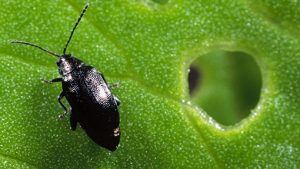
What is a Neonicotinoid?
Neonicotinoids are a group of insecticides based on nicotine. In rapeseed, the chemical is coated in tiny amounts onto the seed to be planted and moves (is translocated) into the growing plant as it emerges from the soil. When a flea beetle nibbles on said plant, there is just enough of the toxic chemical to kill the pest. But otherwise, it is a specifically targeted use of an insecticide in an ingenious way.
Concerns grew that numbers of both honey bees and bumble bees were declining, so scientists explored the potential causes. It appears there are several possible causes including; loss of habitat for bees to feed on and live in; potential pests and diseases affecting bees, such as Varroa mite; changing weather patterns, such as cool damp springs; use of agricultural pesticides.
Some research suggested that small amounts of Neonicotinoid translocated through to the pollen and nectar in the flowering rapeseed plants. When bees visited these flowers they were inadvertently ingesting the chemical which was causing them to lose their bearings; a bit like us trying to find our way home after having too much of a good night in the pub. Other research suggested longer term damage to the fertility of the bee colony.
Although research appeared inconclusive with the debate on both sides being passionate, the EU restricted the use of Neonicotinoids on rapeseed crops from 2013, until such time that more conclusive evidence is shown.
Growing Bee Friendly Rapeseed.
I use several approaches to try and grow a successful crop of rapeseed whilst looking after our bee populations.
– I use a crop rotation and have extended the rapeseed from one in 3 years, to one in 4 to 5 years. This will provide a bigger gap between the crop so as there is less food around for the flea beetle to live off, that will hopefully in time reduce the risk of attack.
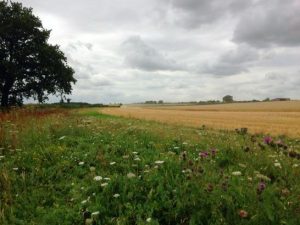
– Established wildflower meadow areas around the farm to create a perfect habitat with a variety of pollinating plants for bees and other beneficial insects to live off.
– Planting the crop into fertile soil, with the use of a healthy crop rotation which includes nutrient building cover crops to give the rapeseed the best possible chance to grow quickly out of the danger period when it is susceptible to flea beetle damage. This is backed up with a small amount of fertiliser if required.
– A local beekeeper has hives on the farm. The bees help fertilise our rapeseed and other crops, making delicious honey in the process.
– I am experimenting by growing companion crops of vetch and clover within the rapeseed. These create a friable soil structure and add nutrition to help the rapeseed plant grow well. It may also confuse a passing flea beetle as to what crop is actually growing in the field and may pass by unaware that their favourite meal is below them.
– As a final resort, we use an insecticide as found in head lice shampoo to kill bad infestations of flea beetle. If we use this, we make sure we spray the crop early in the morning or late at night, as the flea beetle will still be feeding on the crop, but the bees are all tucked up in bed.
In Summary, this hopefully explains some of the conundrums I have as a farmer in trying to do the best thing. Hopefully also, as I write in December 2016, with a temperature of -4.5°C this morning, I am confident that nature will help us enormously in reducing the number of flea beetles surviving the winter.
In the following weeks of June, we have been getting ready to harvest which will now soon be upon us. Marvin has been busy cleaning the grain store from top to bottom, with the help of a German exchange student who stayed with us for five weeks to learn about life on a British farm. He has also methodically gone through every piece of machinery that will be used over the next four months. Each machine has been brought to the workshop. Worn out or broken bearings, pipes, electrical wires, and parts have been repaired and replaced, before the machine is then washed and greased in readiness for work. No doubt there will be something we have missed which will come to light as soon as the machine is used, but good preparations should reduce the chances of downtime when we don’t need it.
At the same time, we are currently making the largest investment to date in Farrington Oils, increasing our oil pressing capacity by two-thirds. I have bought four extra oil presses and storage tanks that have arrived and are waiting to be installed. Father and others are fabricating hoppers and frames for the installation. It is a full team effort in order to get everything finished before harvest, firstly because we will not have time for building projects once the combine starts rolling and secondly because we need the space, as the farm yard currently looks more like an engineering works with half-built machines scattered around the place.
The weather continues to be wonderful in Hargrave over the last few weeks. Unfortunately, although I hate to say, but a little rain would have been appreciated. One day my daughters came back from school in the nearby town, soaked to the skin from a heavy rain storm while they were playing sport, while the sun continued to shine in Hargrave. It is a common occurrence that rain misses Hargrave; there must be some very righteous people living in our village. My only hope is that we do not get a repeat of last year, where the heavens open during August, which was the wettest month of last year by some margin.
Farrington’s Mellow Yellow’s commitment to environmentally sustainable farming has been recognised in The Grocer Gold Awards 2015, the most prestigious awards in the food and drinks industry. The company were shortlisted as finalists in The Green Initiative of the Year category. The awards focus on key business areas including innovation and customer satisfaction and this is a new category for 2015 recognising ‘specific and material achievements’.
Farrington’s Mellow Yellow launched in 2005 but it was two years before its launch in 2003 that farmer Duncan Farrington decided to become a LEAF Demonstration Farm and planted his rapeseed crops under the LEAF Marque standard. This decision to grow and produce his brand of cold pressed rapeseed oil to the highest environmental standards, raised the bar of British produced culinary oils as he led the growth of the sector within the UK.
Duncan has taken a long term approach to environmentally sustainable farming, changing the ethos of his family farm and making a commitment to continual trial, learning and development. Duncan joined LEAF in 1993 and has played a vital role in the wider organisation as a dedicated LEAF farmer.
One of the unique aspects of being a LEAF Demonstration Farm is the accessibility people have to the farm. From the nationwide Open Farm Sunday event to visits from local schools or Woman’s Institutes for example; Duncan regularly hosts farm walks. It is on these walks that you learn how agriculture and the environment go hand in hand and Farrington’s, like many other farmers, create the produce on your local supermarket shelf. Duncan’s personal passion is how he looks after his soils, using the very latest technologies, combined with traditional practices learned over centuries. Indeed, Duncan’s mantra is ‘From healthy soils, we produce healthy oils’.
Cold pressed rapeseed oil continues to grow in popularity and is much loved by chefs and home cooks alike who appreciate its culinary and health properties. Duncan Farrington said ‘Farrington’s Mellow Yellow is the only LEAF Marque branded cold pressed rapeseed oil, and highlights our unique approach to quality production that is at the core of our trusted brand. We are delighted to be recognised in The Grocer Gold Awards 2015’. The Grocer Gold 2015 Awards were announced at a prestigious event at Guildhall London on 9th June 2015. Duncan and Eli Farrington were joined by Caroline Drummond, Chief Executive LEAF, and Kelly Castelete, Marketing Manager for Farrington’s Mellow Yellow. Despite not winning the category, the company were thrilled to be shortlisted and enjoyed the chance to celebrate the success with customers including Booths, Ocado, Hello Fresh, Sainsbury’s and Waitrose.
It’s amazing how a few consecutive days of dry weather completely changes one’s mood after the long wet winter. Fields that were water logged on a Monday morning and looking more appropriate for planting rice than wheat were, by Thursday afternoon, dry enough to start thinking about preparing the soil to plant our spring crops.
From an impatient farmer’s perspective, spring arrived around the middle of March, since when we have been working continuously. It is not just us, as all our neighbours are busy working away in their fields as everything appears to need doing at once.
The first job was to put some fertiliser on the autumn planted crops as soils warm up and day length increases, letting dormant crops realise it is time to start their long growth through spring. To achieve this growth, crops, like humans, require good nutrition to grow healthily, which is gained from the soil and some extra plant food in the form of fertiliser.
Fertiliser applied, attention turned to crops that are not yet planted. Firstly the spring beans, which were planted in pretty much ideal conditions in the third week of March. Next, it is the spring wheat this will take a bit longer to create an ideal seedbed, rather than rushing in just to get the job done quickly. We have started cultivation in preparation for the wheat, but on our heavy clay soils they can change from mud pie texture to concrete in the space of 36 hours, meaning that a mixture of perfect timing, a bit of luck and working with nature rather than fighting it is the name of the game.
In addition to being busy on the farm, we also start thinking about the new season of shows in Farrington Oils. Farrington’s Mellow Yellow is now ten years old and I have always enjoyed meeting customers at food shows, as they provide the perfect opportunity to explain to existing and potential customers why they may like to try our products. The first show of 2015 will be the BBC Good Food Show in Harrogate. We are currently putting the stand together in the office, making sure everything looks spick and span, ready to go, as well as making sure we can get it all in the back of a van to take to Yorkshire. If you are going, we will look forward to seeing you there. If not, then look out for us at other shows during 2015.
Mornings are becoming lighter as day length increases with the tempting hint that spring is coming. Some days are lovely bright and clear, with birds starting to sing and snow drops making an appearance after the long winter nights. Then we have another day of rain falling on saturated soils, just to remind me that spring is not here yet and my hopes of getting to the fields to start our spring planting of crops are still some way off.
I find this time of year frustrating as our heavy clay soils need time to dry out before we can work on them. But if like last year the wet winter persists, April will soon upon us before the crops are in the ground and there is the feeling of fighting a loosing battle with nature, as time runs out for the plants to grow well. Anyway, there is still plenty of time to wait for a few days of sunshine to dry the soils out and bring them back to life after winter.
Until then we have been busy with a couple of winter projects in the workshop. Firstly we have converted an old grain trailer, giving it a new lease of life to transport our digger to different fields. Father and Marvin have cut and welded steel into place and now it is ready for a coast of paint to finish the job off.
The second main project has been the laying of a new drying floor in the grain store. This is a major investment that will dry the crops once it is harvested by blowing warm air through a perforated wood and metal floor. The principle is a bit like a hairdryer, but the scale is somewhat bigger, as the floor is capable of drying around 400tonnes of grain at a time. The floor is laid and now just needs finishing off by laying concrete around the edges. The concrete is ordered and when it arrives, it will be all hands to the deck manning wheel barrows to get the concrete from the lorry to the back of the barn in good time, hopefully without spilling any. If all goes to plan it will be a bit like a synchronised wheelbarrow derby.
www.leafmarque.com
Farming Diary
From LEAF Demonstration Farmer Duncan Farrington

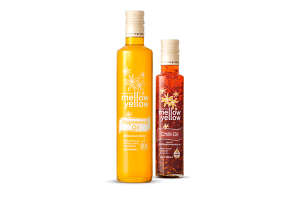 Oils
Oils Rapeseed Oil
Rapeseed Oil Chili Oil
Chili Oil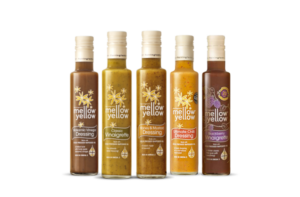 Dressings
Dressings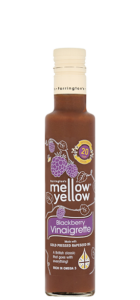 Blackberry Vinaigrette
Blackberry Vinaigrette Classic Vinaigrette
Classic Vinaigrette Balsamic Dressing
Balsamic Dressing Honey & Mustard
Honey & Mustard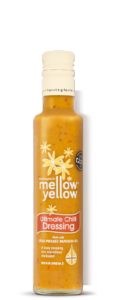 Ultimate Chilli Dressing
Ultimate Chilli Dressing